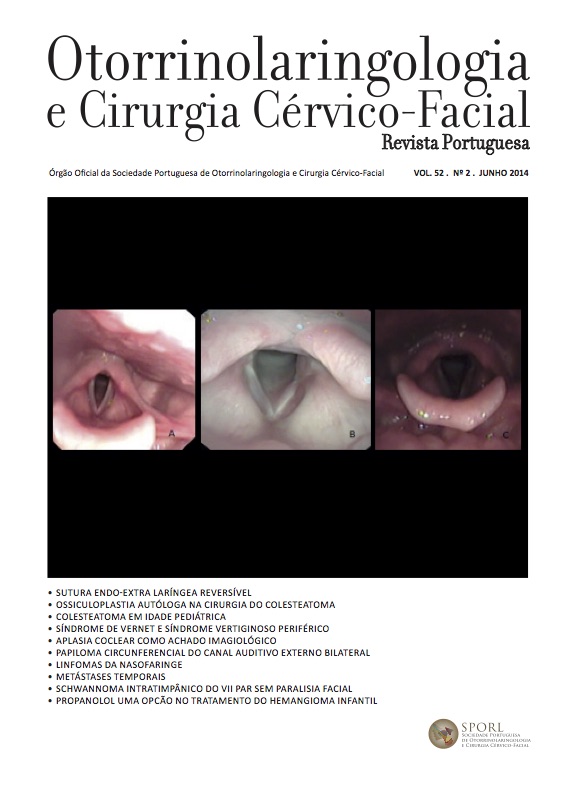Autograft ossiculoplasty in cholesteatoma surgery: A correct option these days?
DOI:
https://doi.org/10.34631/sporl.458Keywords:
cholesteatoma surgery, ear diseases, ossicular replacement, ossicules, ossiculoplasty, autografts, timpanoplasty, postoperative complications, recurrenceAbstract
Introduction: Since the first autograft ossiculoplasty in 1957 with Hall and Rytzner, ossicules remanents became an option in tympanoplasties with ossicular reconstruction due to its biocompatibility, easy availability and low cost. However, its use in patients with chronic otitis media with cholesteatoma declined by the possibility of harboring residual cholesteatoma. The authors investigate if ossicules removed during cholesteatoma surgery have histopathological findings that may lead to cholesteatoma recurrence or to functional compromise in timpanoplasty.
Material and Methods: During 2010 and 2011, ossicules (incus and malleus head) of selected patients were removed during surgery of chronic otitis media with cholesteatoma at Egas Moniz Hospital. Twenty-one ossicules removed from 13 patients were fixed in 10% tamponed formal for 16 hours, decalcified through 48 hours, processed and cut in slices of 3 microns thick. The latter were observed at the optic microscope and histopathology changes documented. Computed tomographies were analyzed retrospectively for correlation between histopathologic and imaging findings.
Results: Four (31%) of the 13 patients, had signs of periosteitis, four other showed remodelative changes, and one patient had cholesteatoma micro-invasion. Futhermore, in the majority of patients the ossicules showed micro-erosions filled with cholesteatoma although it did not invaded the osseous matrix. The histopatologic findings did not show any correlation with the degree of erosion and/or the size of the cholesteatoma.
Conclusions: Taking into account that 38,4% of patients had ossicules with histopathologic features (micro-invasion of cholesteatoma and/or periosteitis) possible of compromising surgery results, the authors do not support the use of ossicules remanents in tympanoplasties of chronic otitis media with cholesteatoma.
Downloads
References
Hall A, Rytzner C. Stapedectomy and autotransplantation of ossicles. Acta oto-laryngologica. 1957;47(4):318-24.
Ng SK, Yip WW, Suen M, Abdullah VJ, van Hasselt CA. Autograft ossiculoplasty in cholesteatoma surgery: is it feasible? The
Laryngoscope. 2003;113(5):843-7.
Stankovic M. Applicability of autologous incus: the influence of age and localization of cholesteatoma. European archives of oto-rhinolaryngology
: official journal of the European Federation of Oto-Rhino- Laryngological Societies. 2007;264(9):995-8.
Dornhoffer JL, Colvin GB, North P. Evidence of residual disease in ossicles of patients undergoing cholesteatoma removal. Acta otolaryngologica.
;119(1):89-92.
Rupa V, Krishnaswami H, Job A. Autograft ossicle selection in cholesteatomatous ear disease: histopathological considerations. The
Journal of laryngology and otology. 1997;111(9):807-9.
Miman MC, Aydin NE, Oncel S, Ozturan O, Erdem T. Autoclaving the ossicles provides safe autografts in cholesteatoma. Auris, nasus,
larynx. 2002;29(2):133-9.
el Seifi A, Fouad B. Autograft ossiculoplasty in cholesteatoma. ORL; journal for oto-rhino-laryngology and its related specialties.
;54(6):324-7.
Subotic R, Femenic B. Histological changes of incus with cholesteatoma in the attic. Acta oto-laryngologica. 1991;111(2):358-61.
Hiranandani LH, Deshpande CK. Histopathological study ofthe middle-ear cleft. The Journal of laryngology and otology.
;83(6):529-50.
Sade J. Epithelial invasion of intraossicular spaces. The Journal of laryngology and otology. 1972;86(1):15-21.






